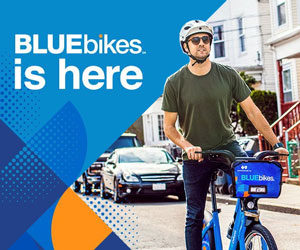
Boston’s “park & pedals” are park and rides for bikes
How do you get more commuters to bicycle into the city? Boston is trying “park & pedals,” dedicated parking lots where suburban commuters can drive to the edge of the city, then bicycle the last couple of miles.
Bicycling is often the fastest way to travel through dense cities. But most commuters from far-flung suburbs aren’t willing to bike that far every day. Park & pedals split the difference, allowing suburban commuters to drive where it’s easier to drive, then bike through the part of the city where it’s easier to bike.
It’s a fascinating idea, and an unusual twist on the last-mile problem of urban transportation.
The last mile
The hardest part about providing transportation from low-density suburban areas is the so-called “last mile.” That’s the gap between commuters’ homes and a major highway or transit line, where there’s not enough people going to the same place at the same time to provide convenient shuttles.
Park and ride lots around transit stations solve that problem by putting the onus on drivers to get to the station. That’s not as efficient as having people live within walking or biking distance of the transit station, but it’s better than making them drive the full distance into the city.
Transit agencies should never design their entire systems around park and ride users, but a few park and rides at strategic locations can be a good thing.
Why shouldn’t the same idea work for bikes? A few parking lots near major bikeways like the Custis Trail and the Metropolitan Branch Trail might indeed prove useful. Particularly if they’re located far from Metro stations, where it’s not so crucial to reserve land for transit-oriented development.
Official vs unofficial
Boston has an official park & pedal network, with designated lots specifically for drive-to-bike commuters. It opened in 2015 and has been expanding this year.
Naturally, an official network isn’t strictly necessary for commuters to combine driving and biking. In the Washington region, people hoping to bike the last mile into the city can park at Metro stations, private lots, or even neighborhood streets.
But official parking lots do have some big advantages over doing it ad-hoc. They’re easier to advertise, and they provide natural places for hubs of bike amenities. With park & pedals, planners could add wayfinding signs, maintenance kiosks, secure bike parking, lockers, even bikeshare stations and bus connections. Each one could become a Union Station-like bike station.
Worth the money?
Car parking is expensive and already abundant. With so many demands on transportation budgets and so little money generally available for bike improvements, spending money to subsidize car parking may be a questionable idea. Better to spend it on bike lanes, bikeshare stations, sidewalks, or transit.
But transportation budgets aren’t all-or-nothing. There could be opportunities to partner with parks, churches, developers, and other property owners to designate park & pedals on the cheap, without the need for expensive construction.
Some of Boston’s park & pedals are simply designated sections of on-street parking on public streets, and therefore a matter of policy more than construction. Nothing says DC could not do the same.
As Washington area planners do more to make bicycling easy, park & pedals may well be one more tool to add to the toolbox.


